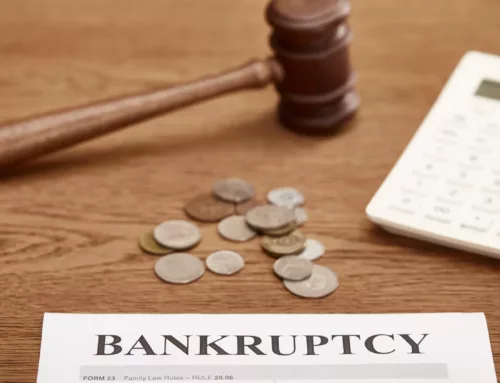Chapter 7 bankruptcy is one of the most common debt relief options that can help you pay off your debts. It’s the quickest, simplest, and most common type of bankruptcy. It is also known as the “liquidation bankruptcy’’ because it discharges most of your unsecured debts including credit card debt, medical bills, and income tax debt. If you’re far behind on your bills and don’t have the means to afford monthly payments and living expenses, filing Chapter 7 bankruptcy could be the last resort to help you reorganize your finances and have a fresh start.
Bankruptcy allows you to discharge some or all of your debts so you no longer have to make payments. However, in some cases, you may want to reaffirm a certain secured debt, agreeing to repay some or all of what you owe instead of requesting to have it canceled or discharged once your bankruptcy case is over. In Chapter 7, your debts can be forgiven; however, it doesn’t change the fact that the lender can claim the assets that you’ve pledged as collateral. In this case, reaffirmation can protect your assets from being claimed by the lender. A qualified Royal Oak bankruptcy attorney can guide you on how reaffirmation can help you save your assets even with bankruptcy Chapter 7.
This article will answer the following questions:
- What is a Reaffirmation Agreement?
- When to Consider Reaffirmation of Debt?
- What Steps Are Involved in Reaffirming a Debt?
- What are the Advantages and Disadvantages of Reaffirmation Agreements?
- What is the Role of a Bankruptcy Attorney?
What is a Reaffirmation Agreement?

A reaffirmation agreement is a document that represents an agreement between the creditor and the debtor who is going through bankruptcy. The agreement allows the borrower to hold onto an asset, such as a home or vehicle, in exchange for repaying some or all of the principal loan amount. It includes important information such as the amount of the debt you’re reaffirming, the repayment terms, the annual percentage rate, details about the collateral (if any), and more.
You need to file a reaffirmation agreement within 60 days from the first date of the meeting of creditors. Once you submit it, it must be accepted by the creditor. The bankruptcy law requires bankruptcy judges to evaluate, review, and approve reaffirmation agreements. The court, however, will not approve the agreement until you’re eligible for immediate discharge.
When to Consider Reaffirmation of Debt?
Reaffirmation can be a sensible way to keep property that is worth significantly more than what you owe on it. However, reaffirming a debt comes with the disadvantage of leaving you stuck in debt after your bankruptcy case ends. Therefore, you should consider it only if:
- you need to keep the collateral
- you are not qualified to redeem the property
- your creditor insists on it
- you have the means to pay off the balance
What Steps Are Involved in Reaffirming a Debt?
Reaffirmation of debt starts with informing your creditor and the court about your plan on reaffirming a certain debt in the Statement of Intentions (Official Form 108) you file with your bankruptcy forms. You and your creditor should write a reaffirmation agreement that must be filed with the bankruptcy court. You need to fill out two forms – Form 27 (reaffirmation cover sheet) and Form 240A (reaffirmation agreement) – that must be filed.
For instance, if you don’t have a lawyer who can sign off the reaffirmation agreement, then the agreement has to be approved by the bankruptcy court for it to be binding. After filing the reaffirmation agreement, there will be a hearing before the bankruptcy judge. The court can reject the application for reaffirmation if it appears to be an undue hardship on your part.
In most cases, the court is unlikely to approve your reaffirmation agreement if:
- the loan is not secured
- you don’t have enough money to make monthly payments
- the interest rate in the agreement is too high
- the property is worth less than the balance of the loan you want to reaffirm
What are the Advantages and Disadvantages of Reaffirmation Agreements?
Before deciding to reaffirm a secured debt, it is advisable to consult a credible Royal Oak bankruptcy attorney to help you determine if reaffirmation of debts can benefit you. You need to consider the following advantages and disadvantages:
A reaffirmation agreement eliminates a specific debt from your bankruptcy discharge and obliges you to make payments based on the terms and conditions of the agreement. It is usually applicable to secured debts which are backed by collateral (home or vehicle). Reaffirmation provides a sure way to keep collateral as long as you abide by the terms of the reaffirmation agreement and keep up your payments. As long as you stay current on the payment, the lender won’t be able to take back the property. It can stop you from losing it through repossession or foreclosure. It can also help reduce the damage that bankruptcy can do to your credit score. Through reaffirmation of debt, you can avoid having to come up with a lump-sum payment to save the asset or property.
In contrast, one disadvantage of reaffirmation is the fact that it doesn’t give you a clean financial slate. You cannot walk away from the reaffirmed debt. If you sign a reaffirmation agreement and file for bankruptcy in the future, you’ll have to pay all your dues. Since you’ve already declared bankruptcy, you’ll have to wait for another 8 years before you can file Chapter 7 again to wipe out the debt. Reaffirming a debt requires a strong financial commitment and can cause a big impact on the effectiveness of your bankruptcy petition.
What is the Role of a Bankruptcy Attorney?
Reaffirmation agreements create binding legal obligations for both debtors and creditors. Therefore, it is important to pay attention to the terms of the agreement. Before you sign a reaffirmation agreement, it’s a good idea to consult our experienced Royal Oak bankruptcy attorneys at Hammerschmidt Stickradt & Associates. We can help you write a reaffirmation agreement and review the agreement terms before you sign it.



